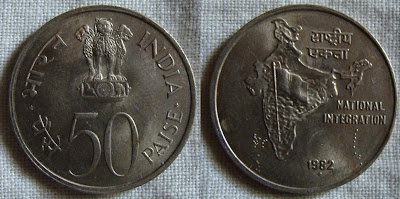50 paise: Jawaharlal Nehru(English)

50 paise: Jawaharlal Nehru (Hindi)

The Jawaharlal Nehru 50 paisa coin had two versions: one having the name written in Hindi, and the other in English. This is the second version.
The Hindi inscription reads 'Jawaharlal Nehru', who was the first prime minister of republic India. He is usually depicted wearing a cap.
Jawaharlal Nehru (14 November 1889[1]. – 27 May 1964) was a major political leader and pivotal figure in the Congress Party, and the first and longest-serving prime minister of independent India, serving from 1947 to 1964. As one of the founders of the Non-aligned Movement, he was an important figure in the international politics of the post-war era. He is also referred to as Pandit Nehru ("pandit," Sanskrit, "scholar", as honorific) and in India, as Panditji (-ji, honorific suffix).
The son of the wealthy Indian barrister and politician Motilal Nehru, Nehru became a leader of the left-wing of the Indian National Congress at a remarkably young age. Rising to Congress President under the mentorship of Mahatma Gandhi, Nehru was a charismatic, radical leader, advocating complete independence from the British Empire, and was eventually recognised as Gandhi's political heir. A life-long liberal, Nehru was also an advocate for Fabian socialism and the public sector as the means by which long-standing challenges of economic development could be addressed.
Nehru raised the flag of independent India in New Delhi on 15 August 1947, and served as Prime Minister. Nehru's appreciation for parliamentary democracy coupled with concerns for the poor and underprivileged enabled him to formulate policies that often reflected his socialist leanings. Both as prime minister and as Congress president, Nehru pushed through the Indian Parliament, dominated by members of his own party, a series of legal reforms intended to emancipate Hindu women and bring equality. These reforms included raising the minimum marriageable age from twelve to fifteen, empowering women to divorce their husbands and inherit property, and declaring illegal the ruinous dowry system. His long tenure was instrumental in shaping the traditions and structures of independent India. His daughter Indira Gandhi and grandson Rajiv Gandhi served as the Prime Ministers of India.
50 paise, 1992

This 50 paise coin shows the denomination country and the four headed lion symbol on the reverse, and the date, mint mark, country, a map of India, and the Indian Parliament on the obverse.
The Indian parliament has two houses, namely the Lok Sabha and the Rajya sabha. The Lok Sabha is also called "house of the people" or the lower house. The members are elected directly by the people from different consitutencies, and these elected members choose or elect the prime minister of India. There can be at most 552 members in this house. The Rajya sabha is also known as the "council of states" or the upper house. Its members are indirectly elected by members of the legislative assemblies of the different states. The Rajya Sabha has 250 members in all. Elections to it are scheduled and the chamber cannot be dissolved. Each member has a term of 6 years and elections are held for one-third of the seats after every 2 years. The members of the Rajya sabha have to be distinguished members are essentially distinguished personalities in their respective fields.
fifty paise, 1972

















































